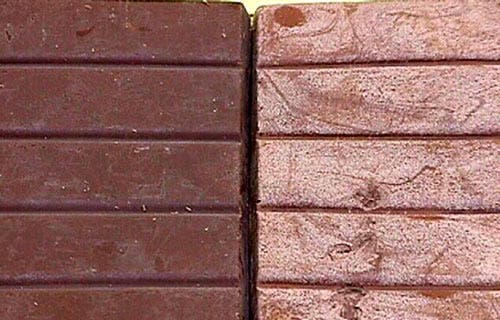Chocolate is the favorite food of many people throughout the world, bringing joy and happiness into our mouths, one square at a time. But when a whitish coating appears on its surface, most people would think twice before eating. That coating, called chocolate bloom, is actually harmless, but it drastically reduces the visual appeal of the chocolate. Now, researchers from the University of Hamburg have studied chocolate bloom using X-rays.
There are two types of chocolate bloom, both of which are white – one is a fat bloom, and the other is a sugar bloom. Chocolate that has “bloomed” is just as safe to eat, but most people simply wouldn’t touch it, so this is a major concern for producers. I was surprised to learn that a lot has been written about this phenomenon, and there are several good practice techniques to avoid causing it.

Chocolate bloom (right) is harmless, but most customers would simply reject it. Image via Wikipedia.
“Although fat blooming is perfectly harmless, it causes millions in damage to the food industry as a result of rejects and customer complaints,” said Svenja Reinke, the lead author of the new study, in a news release. “Despite this well known quality issue, comparatively little has been known until now about its root causes.”
Svenja K. Reinke and colleagues used X-rays to study the bloom, and they report the cause: chocolate is made of ingredients that don’t always stay in one place. Most notably, lipids (fats) can move through pores and cracks, wandering to the surface, where they crystallize. Along the way, they soften and dissolve solid cocoa butter into a liquid form, which can also migrate.
“The experiments that have been conducted allow us as manufacturers of quality chocolate to draw conclusions concerning the root causes of lipid migration leading to blooming,” said Stefan Palzer, one of the researchers, in a news release. “These findings, which we obtained in collaboration with the Hamburg University of Technology and the team at DESY using the latest analytical technologies, provide a solid foundation for developing suitable methods for avoiding one of the most important quality defects in the food industry.”
The findings are published in the journal Applied Materials and Interfaces.









